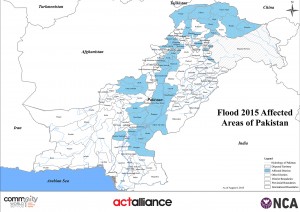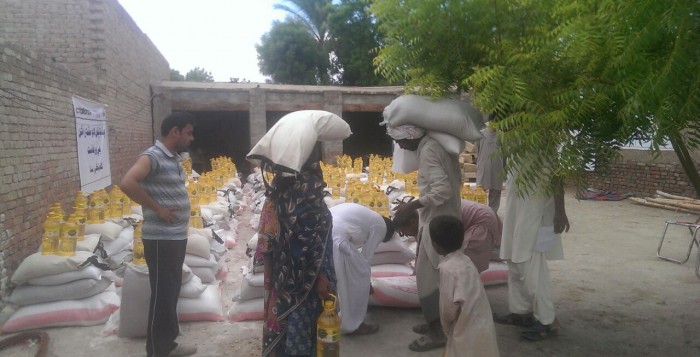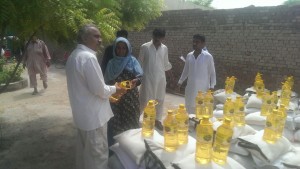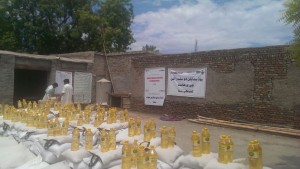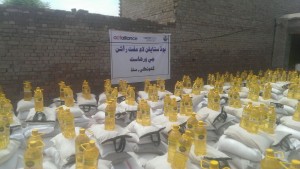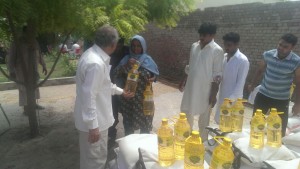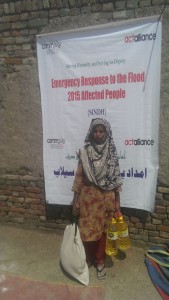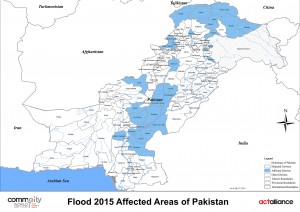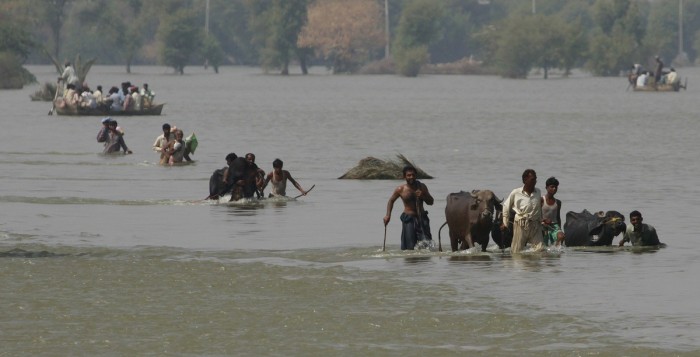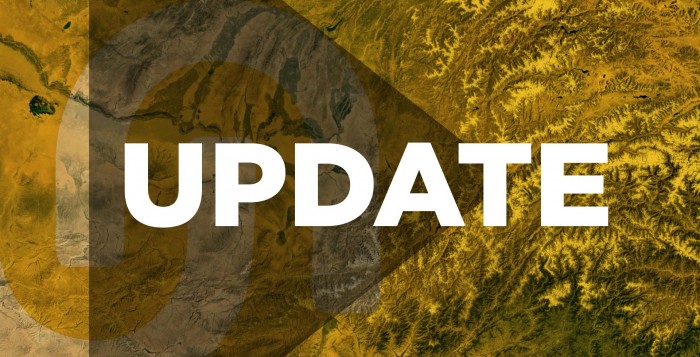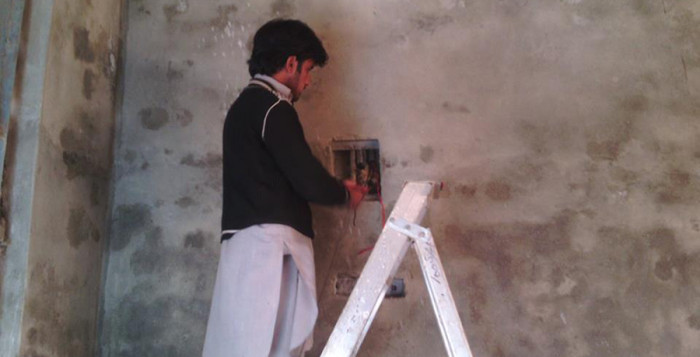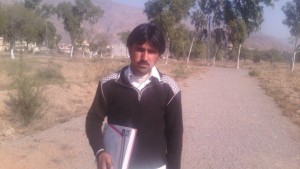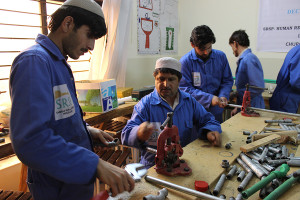Archives
Joint Situation Update: Heavy Monsoon Rains and Flooding Across Pakistan
The ongoing flood emergency is continuing to adversely affect the lives and livelihoods of thousands of communities all across Pakistan and its AJK state. The rains that started in the mid of July have continued for weeks disrupting the lives of many communities. The National Disaster Management Authority (NDMA) have reported 917,791 people as affected; 173 deaths and 127 injuries owing to the devastating floods. In Sindh, the rainfall leading to floods has affected the Katcha area of the six districts however it is anticipated that the floods will drift down to the low lying districts of the province as well.
Damage statistics caused by the floods in the country are indicated in the table below:
| Province | Deaths | Injured | Houses Damaged | Villages Affected | Population Affected |
| AJ&K | 22 | 5 | 237 | 17 | – |
| Baluchistan | 13 | 33 | 798 | – | – |
| Gilgit Baltistan | 7 | 6 | 812 | 286 | 136,000 |
| KPK | 83 | 70 | 3,320 | – | – |
| Punjab | 48 | 13 | 2,025 | 496 | 362,863 |
| Sindh | – | – | – | 2,097 | 418,928 |
| Total | 173 | 127 | 7,192 | 2,896 | 917,791 |
Government authorities have predicted an increase in flooding particularly in Sindh in the upcoming days as heavy monsoon rains are continuing, thus increasing flood water levels in Kabul, Indus, Jhelum and Chenab rivers. The persistent melting of glaciers in Diamer district are further adding to the rise in river waters. The authorities have warned of massive destructions in interior Sindh in the coming weeks when flood water from all of over the country is expected to pass through catchment districts of Indus River in the Sindh province.
Following is a brief overview of the impact the recent flash floods have had on the different provinces of Pakistan so far:
Sindh: Six districts have been severely affected by the floods in Sindh so far and the number of the affected villages is expected to increase rapidly in the following days. The affected districts in Sindh include Kashmore, Gothki, Shikarpur, Khairpur, Sukur and Qambar Shahdadkot. The displaced communities have no choice but to live in tents under open skies on embankments and elevated areas in the affected districts. Anticipating displacement from these districts the government has established relief camps at various embankments.
Khyber Pakhtunkhwa: Eleven districts of the KPK province have been affected by the floods and a lot more damage is expected in the near future due to the unending monsoon rains, land sliding, melting of glaciers and increase in flood level in Kabul and Indus rivers. The affected districts in KPK include Bannu, Batagram, Charsadda, Chitral, DI Khan, Karak, Kohat, Lakki Marwat, Peshawar, Swat and Shangla. However Nowshera and Charsadda are at a higher risk because of the mounting pressure being caused in Kabul River due to the continuing rains.
Gilgit-Baltistan: Diamer, Gilgit, Ghizar, Ghanche, Skardu and Hunza districts have been reported to be severely damaged. A number of roads and connecting bridges have been washed away leaving many villages disconnected from the main towns.
AJK: District Sudhnoti, Neelam, Havaili and Bhimber have been reported to have been affected by the rains and flash floods in 17 villages in the region.
Punjab: Almost 500 villages in Mianwali, Layyah, DG Khan, Rajanpur, Rahimyarkhan and Muzaffargarh districts are left inundated by the floods. Agricultural land spread across 378,172 acres of land have also been destroyed.
Baluchistan: Heavy rainfall, windstorms and the inevitable floods have left districts Zhob, Musakhel, Killa Saifullah, Kohlu and Dera Bugti severely damaged; flood protection bunds, electricity poles, roads, plantations have been impaired. The floods have caused breaches at various locations in the protection bunds claiming four lives so far.
FATA: A number of villages and houses have been reported as damaged in the Khyber and Mohmand agencies of the Federally Administered Tribal Areas. However, exact figures are yet to be reported by the authorities and the national media.
Response by Act Alliance: Community World Service Asia’s project teams are present in KPK, Sindh and Punjab provinces as well as in Azad Jamu & Kashmir. Sindh, positioned on the tail-end of Indus River, is one of the most flood-prone provinces. A number of districts in Sindh are already affected and the thousands of people displaced are in need of food, non-food items (NFIs) and health assistance. Community World Service Asia’s team in Sindh has carried out assessments and has also completed the distribution of monthly food packages to 100 flood affected families. The assistance is to be continued as 2,221 additional families will receive monthly food packages in the coming weeks. Community World Service Asia will also establish a water treatment plant in district Ghotki which will provide treated, clean drinking water to approximately 5,000 flood affected people on a daily basis for a month. Provision of Emergency Health Services has also been proposed in district Ghotki.
Our partner, NCA’s WASH team have also completed an assessment in Punjab and Sindh. In Sindh province, NCA has jointly assessed the situation in district Ghotki together with Community World Service Asia focusing on WASH, health and livelihoods. NCA’s assessment covers Layyah, Muzaffargarh and Rajanpur districts in Punjab province and Ghotki, and Kashmore districts in Sindh province. The assessment team has conducted a rapid survey using semi-structured questionnaires, key informant interviews, FGDs and interviews with government stakeholders to gather important information on access, vulnerability, coping capacity, available resources and existing key risks. The assessment has been compiled.
As part of NCA’s emergency preparedness plan, the organization is mobilizing its pre-positioned mobile Water Treatment Units (WTUs) for immediate use. Each unit can purify and provide clean drinking water to 5,000 individuals based on SPHERE standards. Keeping in view the urgent needs and NCA’s life saving response capacity, it is utilizing its internal funds (through their head office) to provide emergency funds to immediately mobilize the WTUs. As planned for this response, six WTUs will provide water to alteast 30,000 individuals at this crucial stage. The budgeted amount is calculated for a three months response.
Contacts:
Allan A. Calma
Deputy Director
Disaster Management Program
Email: allan.calma@communityworldservice.asia
Cell: +92 301 5801621
Muhammad Fazal
Associate Director
Emergencies/DRR/Climate Change
Email: fazil.sardar@communitryworldservice.asia
Cell: +92 332 5586134
Palwashay Arbab
Head of Communications
Email: palwashay.arbab@communityworldservice.asia
Ph: +92 42 3586 5338
Sources:
www.ndma.gov.pk
www.pmd.gov.pk
Situation Update: More Rains Prediction to further intensify the flood damages Across Pakistan
The monsoon rains that struck Pakistan in the third week of July are still continuing across the country. As a result of the heavy monsoon rains and melting of glaciers in the north of country, there has been widespread flooding in different regions of the country. The table below shows the level of damages reported till today:
| No. of Casualties | People injured | Houses damaged | Villages affected | Total affected population |
| 146 | 66 | 3,133 | 2,073 | 752,274 |
The floods have also severely damaged the infrastructure and local livelihoods of many parts of rural and semi-urban Pakistan; agricultural fields and crops have been damaged. A number of local markets, link roads, connecting bridges and micro-hydro power stations have been reported damaged as well.
As per the latest reports of the Pakistan Meteorological & Hydrological Department, the River Indus at Guddu Barrage is likely to attain a High to very High flood level ranging between 650,000 cusecs to 750,000 cusecs during 1400 PST of August 1st to 2400 PST of August 3rd 2015. It was further added that the flood levels will continue to remain high for the following seven days.
River Indus at Sukkur is also reported to maintain a High to very High flood level ranging between 650,000 cusecs to 750,000 cusecs during 1200 PST of August 2nd to 2400PST of August 4th2015. Flood levels will remain high for the next seven days in this region as well.
Unceasing heavy monsoon showers are expected in the coming days across Pakistan and a further increase in the water levels in Kabul, Indus, Jhelum and Chenab Rivers may intensify the flooding in Sindh. The Director General of the Meteorological Department still maintains as per his earlier message that India is also likely to release excess water from its dams in the following days which can upsurge flooding in the low-lying areas of Pakistan also. The authorities have warned of massive destruction in interior Sindh in the subsequent weeks as flood water from all of over the country will pass through catchment districts of Indus River in the Southern province.
The impact of the latest flash floods on different provinces of Pakistan are indicated briefly below:
| SINDH | ||||
| No. of Casualties | People injured | Houses Damaged | Villages Affected | Total affected population |
| 16 | -* | -* | 1,423 | 281, 921 |
| * No definite number available yetThe affected communities displaced are forced to live in tents and under the open sky or on embankments and elevated places in the affected districts. The government has established relief camps at various embankments for the affected people however people have been reported to prefer to live in open spaces instead. The provincial government together with the Pakistan Army is providing rescue and evacuation services to the flood affected communities and villages. | ||||
| KHYBER PAKHTUNKHWA (KPK) | ||||
| No. of Casualties | People injured | Houses Damaged | Villages Affected | Total affected population |
| 73 | 31 | 348 | 292 | -* |
| * No definite number available yetChitral is the worst affected district in KPK province. Majority of the villages have lost land-connections that they had between major cities as link roads and connecting bridges, micro-hydro power stations have been severely damaged. The Government has distributed relief items including tents among the displaced families and has also announced a cash compensation of PKR. 0.5 Million for each affected family that has lost their house in the floods in Chitral. | ||||
| GILGIT BALTISTAN | ||||
| No. of Casualties | People injured | Houses Damaged | Villages Affected | Total affected population |
| 5 | 2 | 653 | 175 | 136,000 |
| * No definite number available yetGhizar, Astor, Skardu and Hunza districts have been reported to be severely damaged. A number of roads and connecting bridges have been washed away that has left many villages disconnected from the main towns. | ||||
| Azad Jammu and Kashmir (AJK) | ||||
| No. of Casualties | People injured | Houses Damaged | Villages Affected | Total affected population |
| 20 | 8 | 189 | -* | -* |
| * No definite number available yetDistrict Sudhnoti, Neelam, Havaili and Bhimber have been reported to affect by the rains and flash floods. | ||||
| Punjab | ||||
| No. of Casualties | People injured | Houses Damaged | Villages Affected | Total affected population |
| 22 | 4 | 553 | 466 | 334, 353 |
| Villages in Mianwali, Layyah, DG Khan, Rajanpur, Rahimyarkhan and Muzaffargarh districts are most severely swamped by the flood water of River Sindh. Out of the total affected population in Punjab, 59250 are reported to be living in 27 relief camps established by the Government. Crop fields spread across 233,688 acres of land have been totally destroyed. | ||||
| Baluchistan | ||||
| No. of Casualties | People injured | Houses Damaged | Villages Affected | Total affected population |
| 10 | 24 | 620 | -* | -* |
| * No definite number available yetHeavy rainfall, windstorms has affected Districts Zhob, Kohlu and Dera Bugti with flooding. Flood protection walls, electricity poles and links roads have been damaged while trees and plants have been uprooted as well. High flood levels in Guddu and Taunsa barrages are posing a probable threat to more districts of Baluchistan. | ||||
| Federally Administered Tribal Areas (FATA) |
| A number of villages and houses have been reported to be damaged in Khyber and Mohamand agencies of Federally Administered Tribal Areas. However, exact figures have yet to be reported by the authorities and national media. |
Response by Community World Service Asia: Community World Service Asia’s Disaster Response Team are present in KPK, Sindh and Punjab provinces as well as in Azad Jammu & Kashmir. Sindh, positioned on the tail-end of Indus River, is one of the most flood-prone provinces. A number of districts in Sindh are already severely affected and thousands of people are in dire need of immediate food, NFI and health assistance. Community World Service Asia has been able to assist 100 most vulnerable flood affected families in district Ghotki with provision of one month food rations. One month food ration among another 827 families will be distributed in the coming weeks.
Contacts:
Allan A. Calma
Deputy Director
Disaster Management Program
Email: allan.calma@communityworldservice.asia
Cell: +92 301 5801621
Muhammad Fazal
Associate Director
Emergencies/DRR/Climate Change
Email: fazil.sardar@communitryworldservice.asia
Cell: +92 332 5586134
Palwashay Arbab
Head of Communications
Email: palwashay.arbab@communityworldservice.asia
Cell: +92 42 3586 5338
Sources:
www.ndma.gov.pk
www.pdma.gov.pk
www.tribune.com.pk
www.dailytimes.com.pk
www.express.com.pk
Situation Update: Heavy Monsoon Rains and Flooding Across Pakistan
Download updated map indicating the latest flood situation of Pakistan
Heavy monsoon rains hit different parts of Pakistan starting the third week of July and are still going strong. These rains along with rapid melting of glaciers have resulted in massive flooding across the country. Till date, 145 people have been reported to have died, while 36 people have been injured because of this heavy downpour and floods. Three thousand and fifty houses are damaged and 451 villages have been totally inundated while many more villages have been partially affected resulting in the displacement of around 3, 85,957 people across the country. These latest floods have also severally damaged the infrastructure and the local livelihoods. A total of 715 cattle have perished in the floods, and 233,688 acres of agricultural land, local markets, roads, bridges and micro hydro-power stations have been damaged.
The Government authorities have predicted an increase in flooding especially in the Sindh province in the upcoming days due to the continuing rains, increase in flood water level in Kabul, Indus, Jhelum and Chenab rivers, and the further melting of a glacier in Diamer district. According to the Director General of the Meteorological Department, India has also released 150,000 cusecs of flood water which means 0.8 million cusecs of water is currently passing through the Guddu Barrage. India is likely to release more surplus water from its dam in the coming days which will further increase flooding in the low-lying areas of Pakistan. The authorities have warned of possible massive destruction in interior Sindh in the following weeks as flood water from all of over the country will be passing through catchment districts of Indus River in the province.
Following is a brief overview of impact of recent flash floods on different provinces of Pakistan so far:
Sindh: 16 people have died because of rains and floods and many more have been reported injured as of today. Six districts and over 300 villages have been affected by the floods in Sindh so far and many more villages are expected to be gravely affected in the days to come. The affected districts in Sindh include Kashmore, Gothki, Shikarpur, Khairpur, Sukur and Qambar Shahdadkot. Over 100,000 people have been displaced and are forced to live in tents and under the open sky on river embankments and elevated places in the affected districts. Anticipating displacement from these districts the government has established relief camps at various embankments in Sindh. The provincial government together with 800 personnel from the Pakistan Army is providing rescue and evacuation services to the people from the flood affected villages. Hundreds of people currently living in the open air and under tents are at risk of being highly food insecure.
Khyber Pakhtunkhwa (KPK): Three districts and 292 villages have been affected by the floods in KPK where 74 people have died and 15 have been injured so far. Many more damages are expected to follow in the coming days because of the continued monsoon rains, land sliding, melting of glaciers and increasing water levels in Kabul and Indus rivers. The affected districts in KPK include Chitral, Peshawar and Shangla while Nowshera and Charsadda are at high risk because of mounting pressure in Kabul River and continued monsoon rains. Chitral is the most affected district where 64 people have died and 31750 houses have completely washed away with the flood water. Majority of the villages have lost land-connections with the major cities because of destruction of roads and connecting bridges and micro-hydro power stations. The Government has distributed relief items including tents among the displaced families and have also announced PKR. 0.5 million in cash for each family that have lost their homes due to the floods in Chitral.
Gilgit-Baltistan: Ghizar, Astor, Skardu and Hunza districts have been most damaged in this region. Six hundred and twenty five houses have reported to be fully damaged while many more were reported to be partially damaged as result of rains, landslide and flashfloods. Two people have been reported to have died because of rains/flash floods in this area. A number of roads and connecting bridges have been washed away that had left many villages disconnected from the main towns.
AJK: Districts Sudhnoti, Neelam, Havaili and Bhimber have been reported as worst affected by the rains and flash floods in this region. Thirteen people were reported to have died while eight have been injured and a hundred houses were reported as fully damaged.
Punjab: At least 31 people have died and 4 people have been reportedly injured as a result of the floods and vicious rains in the Punjab province. Four hundred and thirty three villages in Mianwali, Layyah, DG Khan, Rajanpur, Rahimyarkhan and Muzaffargarh districts are left flooded by the overflow of water from the Sindh River. 285,957 people have been reported affected out of which 59250 are living in 27 relief camps established by the Government. Agricultural fields spread across 233,688 acres of land have also been destroyed.
Baluchistan: Heavy rainfall, windstorm and the flood situation in District Zhob has damaged flood protection bunds, electric poles, roads, uprooting trees, etc. The floods have also caused breaches at various locations of the protection bunds claiming four lives so far. In the central province, at least twenty-one people drowned in the flood water, however, only seven dead bodies have been recovered. The search and rescue operation is underway for the recovery of the rest of the drowned people.
FATA: A number of villages and houses have been reported to have been fully damaged in Khyber and Mohamand agencies of Federally Administered Tribal Areas. However, exact figures have are yet to be confirmed by the authorities and national media.
Response by Community World Service Asia: Community World Service Asia’s field teams are present in KPL, Sindh and Punjab provinces as well as in Azad Jamu & Kashmir. Sindh, positioned on the tail-end of Indus River, is among the most flood-prone provinces. A number of districts in Sindh are already affected and thousands of people are displaced who are now in dire need of food, NFIs and health assistance. Community World Service Asia’s field team in Sindh is carrying out assessments in the affected districts and has also started distribution of one month food rations to hundred most affected families in Gothki district of Sindh province. Another one month food rations among another 827 families will be distributed in the coming weeks.
Contacts:
Allan A. Calma
Deputy Director
Disaster Management Program
Email: allan.calma@communityworldservice.asia
Cell: +92 301 5801621
Muhammad Fazal
Associate Director
Emergencies/DRR/Climate Change
Email: fazil.sardar@communitryworldservice.asia
Cell: +92 332 5586134
Palwashay Arbab
Senior Communications Officer
Email: palwashay.arbab@communityworldservice.asia
Ph: +92 42 3586 5338
Sources:
http://www.nawaiwaqt.com.pk/E-Paper/Lahore/2015-07-28/page-1/detail-24
http://www.thekawish.com/beta/
www.tribune.com.pk
www.e.dunya.com.pk/National Humanitarian Network
www.ndma.gov.pk
weather.par.com.pk
http://epaper.pknewspapers.com/the-kawish.html
Express News, July 27, 2015 http://www.pdma.gos.pk/new/Docs/flood2015/SER-1-25-2015.pdf
http://www.pdma.gos.pk/new/Docs/flood2015/24-7-2015STOCKSPOSITION.pdf
Situation Update: Floods High Alert issued
Monsoon rains and flood continues to create havoc in different parts of the flood affected areas leaving thousands of families affected, number of houses destroyed, thousands of acres of ready to harvest crops and fruits orchards have been damaged, link roads and bridges destroyed. The Pakistan Meteorological Department (PMD) Director General Dr Ghulam Rasul has issued high alert in the wake of expected widespread heavy rain and flood, over the next five days.
The PMD spokesperson added that the heavy monsoon was concentrating in Sindh where up to 500,000 cusecs of water was already flowing down the Indus at Guddu and Sukkur and the upcoming heavy downpour could aggravate the situation. According to the PMD the entire country is currently under an active monsoon system which might generate heavy widespread rains in coming days. National Disaster Management Authority (NDMA) also alerted that a sharp peak of High Flood is expected in River Jhelum at Mangla (upstream).
Following is a brief overview of impact of recent flash floods on different provinces of Pakistan so far:
Sindh: Around 150 villages have been flooded in district Ghotki, Kashmore and Sukkur which affected around 1000,000 people. The continuous driving rains incited rivers to wreak havoc and forced the citizens to shift to safer locations along with their livestock. Along with the three already affected districts, the Provincial Disaster Management Authority of Sindh has forecasted that districts Khairpur, Larkana and Shikarpur are also at high risk of flooding in the coming two to three days which can affect thousands of families in these vulnerable districts. Anticipating displacement from these districts the district governments have established relief camps, health camps and livestock facilities at various embankments.
Khyber Pakhtunkhwa: Around 300,000 people in upper and lower Chitral are affected by flash floods. Twenty-six villages are affected in the district, where 145 houses were destroyed and 32 partially damaged. The roads linking Chitral with Drosh, Orghoch, Garam Chashma, Bamboret, Mastuj and Boni are destroyed. Dozens of other link roads, major bridges and the suspension bridges connecting valleys and villages have been swept away in the gushing waters. A hotel, a private college and around 25 water supply schemes have also been swept away. Search and rescue operations are currently underway by Pakistan Army. Relief camps have been established in the affected areas while Government has announced PKR 500,000 for each of the completely affected households. Furthermore PRCS has distributed tents, kitchen sets, hygiene kits, Mosquito nets and blankets to 29 flood affected families. KP government has transported 20 tons of food packs to district Chitral.
Gilgit-Baltistan: Flash floods have cut off at least three valleys in Diamer and Baltistan. The valleys in Diamer – including Niat, Buner and Fairy Meadows – have been experiencing food shortages because of lack of connection with the outside world. Ghanche and Skardu are the worst affected districts of GB. Fast melting glaciers in the northern areas of the country during monsoon season and the resultant flash floods is a wake-up call for the K-P and G-B governments to start planning to tackle the situation.
Punjab: At least 244 villages of Mianwali, Layyah, DG Khan, Rajanpur, Rahimyarkhan and Muzaffargarh districts are inundated by the flood water of Sindh River. According to NDMA, 11 villages in Mianwali, 81 in Layyah, 40 in DG Khan, 14 in Muzaffargarh, 82 in Rajanpur and 16 villages in Rahimyar khan are affected by the flood. Crop fields spread on thousands of acres have been destroyed, while more than 100 families have moved to safer areas on their own due to insufficient arrangements made by the district and tehsil governments. A large number of people are stranded in the flooded localities. The urban localities which are on the bank of Lai Nallah in district Rawalpindi have also been flooded while due to the rain related incidents in the district, a girl has died during the last 24 hours. Government has established 120 relief camps in six districts of the province. Each camp will accommodate 500 people. 6,000 tents and 10,000 food packs are distributed so far.
Baluchistan: Heavy rainfall, windstorm and the flood situation in District Zhob has damaged flood protection bunds, electric poles, roads, uprooting trees, etc. Also caused breaches at various locations to the protection bunds claiming four lives so far. In central province, at least twenty-one people drowned in the flood water where only seven dead bodies recovered while search and rescue operation is underway for the recovery of the rest of the drowned people.
Response by Community World Service Asia:
Sindh being the tail-ender has always been the most affected province and is likely to be among the most affected by recent rains and flooding in the coming couple of days. Community World Service Asia has operational offices and teams in Sindh. Its senior management team, including Regional Representative and Associate Director for Emergencies is on the ground monitoring the situation and will be leading the emergency response. The field team is coordinating with key stake holders to plan to address emergency needs of the population by providing food, NFIs and emergency medical assistance in affected districts.
Contacts:
Allan A. Calma
Deputy Director
Disaster Management Program
Email: allan.calma@communityworldservice.asia
Cell: +92 301 5801621
Muhammad Fazal
Associate Director
Emergencies/DRR/Climate Change
Email: fazil.sardar@communitryworldservice.asia
Cell: +92 332 5586134
Palwashay Arbab
Senior Communications Officer
Email: palwashay.arbab@communityworldservice.asia
Cell: +92 42 3586 5338
Sources:
www.tribune.com.pk
www.e.dunya.com.pk
National Humanitarian Network
www.ndma.gov.pk
weather.par.com.pk
Situation Update: Rain and Flood situation in different parts of the country
Torrential rains have created havoc in different parts of the country making life miserable for the residents of the affected areas. District Chitral is on top of the list of the worst affected districts where Infrastructure has been the worst-hit and the upper areas of the district have virtually been cut off from the rest of Chitral, leaving as many as 200,000 people stranded.
Kyber Pakhtunkhwa: Initial assessment has revealed massive damages, while officials have reason to believe that the actual situation could be much worse.
The PDMA said the available machinery and manpower had already been deployed for temporary opening of routes to restore communication.
Around 40 connecting bridges and more than 200 smaller bridges have been washed away. An estimated 175 houses were completely destroyed while over 200 others were partially damaged.
Three towns of Latkoh tehsil – Garam Chashma, Arkari and Karimabad – have been inaccessible for the past six days.
Electricity and water supply systems have also been destroyed, while a shortage of edible items has also been reported.
Standing maize and vegetable crops, and the villagers’ cattle and other belongings were swept away, but no loss of life was reported there. However, a girl was killed in the Bakarabad area of Jamrud in Khyber Agency when the roof of a house collapsed because of the heavy downpour.
Punjab: Around 100 villages have been flooded in district layyah, while due to high level flooding in Indus river, thousands acres of crop has been destroyed in district Rajanpur and adjacent areas. The affected people are compelled to evacuate the area and to move to safer places.
Balochistan: Three children were killed and more than a dozen people injured in rain-related incidents in the northern parts of Balochistan, where torrential rains played havoc and disrupted road communication. The protection wall of Sherani was washed away by hill torrents as well, flooding the residential township and the nearby villages. A bridge linking Zhob and Sherani also collapsed, suspending road communication. Heavy rains were also reported in Ziarat, as the downstream in Sibi Valley of the plains was inundated.
Sindh: At least 10 people drowned while swimming or accidentally falling into waterways in separate incidents. The flood water is expected to reach Sindh districts and affect the low lying areas on the bank of the rivers in the next few days.
The PMD has issued a red alert for flash flooding in local nullahs and streams of Punjab, upper K-P, eastern Balochistan and Kashmir for the next three days.
The Met Office has warned the local authorities to take preventive measures to avoid any kind of human or property loss.
PMD meteorologist Muzammil Hussain said the second spell of monsoon would continue across the country until July 30, with weak to moderate showers with short intervals.
He said hot and humid weather would persist across the country, adding that the humidity level had reached 70 per cent.
Community World Service Asia is currently monitoring the situation and will respond if the emergency assistance is required.
Contacts:
Allan A. Calma
Deputy Director
Disaster Management Program
Email: allan.calma@communityworldservice.asia
Cell: +92 301 5801621
Muhammad Fazal
Associate Director
Emergencies/DRR/Climate Change
Email: fazil.sardar@communitryworldservice.asia
Cell: +92 332 5586134
Palwashay Arbab
Senior Communications Officer
Email: palwashay.arbab@communityworldservice.asia
Ph: +92 42 3586 5338
Sources:
www.tribune.com.pk
www.express.com.pk
Situation Update: Heavy Monsoon Rains Triggered Flash Flood in Chitral
Photo Courtesy: Focus
Heavy monsoon rains triggered flash floods in different parts of the north-west district of Chitral in KPK, Pakistan. Two people including a woman and a girl have been reported missing since the floods. Thirty shops and dozens of bridges have been washed away by the gushing waters of a flood stream in various parts of the district. The rain started pouring early in the morning and lashed the district for a continuous half-an-hour, causing a powerful flash flood. According to the Provincial Disaster Management Authority (PDMA), around 100 villages have been affected, including those in Bumboret, Ayun, Birir, Shali, Shughur, Khairabad, Milp and Dorosh.
The meteorological department said the rain hit mountainous areas which caused the floods in low-lying parts of the district. The floods washed away roads within the district, including Peshawar-Chitral Road near Broz Gol area. There is no land route connecting Chitral city to the rest of Malakand Agency. Embankments at vulnerable points are required to protect communities from overflow of river and its tributaries in the affected areas.
A sizeable portion of population has been cut off which necessitates immediate restoration of roads and bridges. The floods have also affected the WAPDA house in the area which has resulted in the disconnection of the power supply from Inji Grid Station and Ayun Hydel Power Station, plummeting most parts of the district into darkness.
Meanwhile, officials warned that water levels in the River Indus were on the rise. According to sources Abdul Aziz Soomro, the in-charge of the control room at Sukkur Barrage, said that a medium-level flood was passing through Guddu Barrage while a low-level flood was passing through Sukkur Barrage. He said that water levels are expected to rise further in the next 24 hours at Guddu and Sukkur barrages.
Community World Service Asia is continuously monitoring the situation and its emergency response teams are ready to start emergency response activities if required. To view the contingency plan for emergency response, click here to download Monsoon Contingency Plan.
Contacts:
Allan A. Calma
Deputy Director
Disaster Management Program
Email: allan.calma@communityworldservice.asia
Cell: +92 301 5801621
Muhammad Fazal
Associate Director
Emergencies/DRR/Climate Change
Email: fazil.sardar@communitryworldservice.asia
Cell: +92 332 5586134
Palwashay Arbab
Senior Communications Officer
Email: palwashay.arbab@communityworldservice.asia
Cell: +92 42 3586 5338
Situation Alert: Heavy Rains Predicted in Different Parts of Pakistan in the Coming Week
The Pakistan Meteorological Department (PMD) on Sunday predicted heavy rains in Khyber Pakhtunkhwa (KPK), northeastern Punjab and Azad Jammu and Kashmir (AJK) during the coming week.
Heavy rains forecasted within the next 24 hours in Malakand, Makran, Kalat, Gilgit-Baltistan and Kashmir are to be accompanied by powerful gusts of wind.
Rainfall of up to 200 millimeters (mm) may occur in these areas within the next 24 hours. The normal rainfall for Pakistan’s monsoon season is usually expected to be around 141mm, while this expected rainfall of up to 200 mm (which is 42 % above the normal range) could cause flooding.
Year Rainfall (mm) Range
2011 236.5 67 % above normal
2012 185 31 % above normal
2013 148 5% above normal
2014 113 20 % below normal
The trend analysis of the rainfalls in Pakistan for the last four years indicates that the average rainfall from 2011 to 2014 had gradually decreased however the current expected rainfall of 200 mm may change the trend again. This anticipated changed pattern may generate high level flooding in the target areas.
Excess rainfall in the Kabul River catchment area along with the snow melting may also cause flooding along connected riverbanks.
Moreover, the deep depression over the east central Arabian Sea has intensified further into a tropical cyclone which is likely to move north-westward in the next 24 hours. Under the influence of this system thundershowers are expected in Karachi, Hyderabad, Mirpurkhas, Tharparkar, Thatta, Badin and Sujawal districts of lower Sindh in the next 24-48 hours and in southern Baluchistan in the next 36 hours.
Contacts:
Allan A. Calma
Deputy Director
Disaster Management Program
allan.calma@communityworldservice.asia
Cell: +92 301 5801621
Muhammad Fazal
Associate Director
Emergencies/DRR/Climate Change
fazil.sardar@communityworldservice.asia
Cell: +92 332 5586134
Palwashay Arbab
Senior Communications Officer
palwashay.arbab@communityworldservice.asia
Ph: +92 42 3586 5338
Sources:
www.pmd.gov.pk
www.dawn.com
Imparting Skills and Securing futures
Since 2009, the ongoing conflict in the Federally Administered Tribal Areas (FATA) and its adjoining regions has resulted in a mass displacement of its population to different districts of Khyber Pukhtunkhwa (KPK). More than thirty thousand families from these displaced communities have migrated to Kohat, a city located at around 70km from Peshawar. To support the displaced community in Kohat, Community World Service Asia (formerly CWS-P/A) in partnership with Dan Church Aid (DCA), is providing livelihood interventions to improve food security among selected migrants and host communities.
During consultative meetings with the affected population, lack of skills for income-generation and food production opportunities were identified as a prime concern among the conflict affected populace in Kohat. To reduce these vulnerabilities, Community World Service Asia provided skills training fifty men and fifty women from the target communities on tailoring, embroidery, welding and plumbing. Selection of training was made depending on each trainee’s requirement and choice. Supporting toolkits to continue practice of the learnt skills were also provided to the training participants.
Trainings to the fifty men were provided by implementing partners Sarhad Rural Support Program (SRSP) in Kohat. Dilawar Khan, Samiullah Khan and Shah Jee Khan are three of the selected participants of the trainings provided. The three of them shared how this intervention by Community World Service Asia has made an impact on their lives since their displacement.
“At the time of selection, I thought that this training would be a waste of time but the trainer worked very hard with me and made me realize how helpful it was. I am very much thankful to Community World Service Asia and SRSP for conducting this training. Now I have a skill and can earn better for my family. Before I took this training I barely earned four to five thousand a month, in which it was very difficult to manage my household expenses. I am hopeful that I will get more work opportunities in my own village now and will be able to send my children to school and provide them with better education.”
Dilawar, 26 years old, is married has three children. He lives in a joint family with the total of 22 household members. Before displacement his family’s main livelihood was farming on their own native land. In Kohat, they have no source of income and live in a rented house.
“I am very happy for being nominated for the plumbing skills training. I practically learnt how to use all the plumbing tools and completed the training in a good environment. Before participating in this training I had no skills to earn an income for my family and myself. Today I have a skill and it empowers me to earn a better livelihood and lead a comfortable life. When I went back home upon successful completion of the training course, I started practicing the skills learnt and started doing some repair work for my neighbors and relatives in the village which enabled me to earn sufficient money. I was also trying to get work outside the village and finally one of my relatives who is engaged with sanitary tools business in Peshawar called me and employed me at his shop. After a week, myself and three other training graduates secured a contract for completing the sanitary construction work at a newly constructed building in Peshawar at forty thousand rupees per month”.
Shah Jee Khan belong to the Bakezai Banda village in Kohat. He is 29 years of age, is married and has two children. He had no source of income when he migrated to Kohat.
“Vocational trainings conducted by SRSP and Community World Service Asia equipped me with the skills I needed and paved the way to earn a respectable livelihood for me and my family. When I came after completing the training course, I was contacted by my trainer who informed me about scheduled test interviews of UAE based MBC company in Chota Lahore District Swabi for hiring. I appeared for test/interviews on the mention date and time and passed it with good marks. The company selected me for the post of a plumber. I was offered a two year valid visa with a monthly salary of AED.1000, excluding allowances for overtime, food and accommodation. I was told that I shall get visa confirmation within 20 days. Before taking this training I was unemployed and was very worried about my future as I had no professional skill and work experience. I am very much grateful to Community World Service Asia for providing me with a hope for a bright future”.
Samiullah Khan belongs to the Afridi Banda village in Kohat. He is 21 years of age, is unmarried and lives with his parents. His father is disabled which is why Samiullah is the sole income bearer of the family.
Making food safety a priority
An awareness session on food and water hygiene was held in the Community World Service Asia Mansehra office and in three of its Basic Health Units in Barari, Khaki and Ichrian in celebration of the World Health Day on April 7, 2015. The discussions of the day were centered on the importance of consuming hygienic food. Community members were made aware of the many food borne illnesses that are prevalent due to lack of proper food management and unhygienic nutritional consumption.
Health experts from the MNCH Project team physically demonstrated the difference between hygienic and unhygienic food. They displayed how some food may appear to be safe for consumption but actually would not be. They taught ways of how community members could identify these food contaminations that otherwise go unnoticed, and sanitize their sustenance in a way that would make it safe for their consumption. As this year’s World Health Day’s international theme was “food safety”, the activities conducted in Mansehra focused mainly on the emerging health problems and diseases caused by unhygienic food consumption. A great emphasis was laid on the considerable amount of improvement in living conditions of communities if all individuals started being conscious of food safety.
The team based their awareness sessions on WHO’s guidelines on safer food and on how community members must incorporate these in their homes and villages. The five key points of the guidelines were to keep clean; to separate raw food from cooked food; to cook food thoroughly, to keep food at safe temperatures and to use clean water and cooking utensils.
Community World Service Asia celebrated the World Health Day to promote the “FROM FARM TO PLATE, MAKE FOOD SAFE” global campaign in an effort to streamline food safety through its projects and among the communities it works with.






